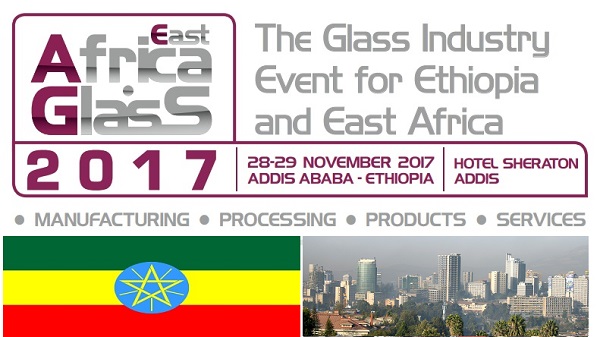
EVENT: East Africa Glass 2017
DATE: November 28-29, 2017
VENUE: Sheraton Addis Hotel, Addis Ababa, Ethiopia
East Africa Glass 2017: The Glass Industry Event for Ethiopia and East Africa
Ethiopia is definitely one of the most promising African countries, also thanks to its population of 100 million inhabitants, about 46 per cent of whom estimated to be under the age of 15. Numerous opportunities are open to improve the industrial sector: the Ethiopian government has significantly reduced customs tariffs in many sectors and it is supporting investors through fiscal and non-fiscal incentives, such as granting land for free. According to the Ethiopian Investment Commission, the areas of opportunities include the construction sector and the pharmaceutical industry, besides bottled drinks. In 2014, the Ministry of Industry commissioned to the Addis Ababa Institute of Technology a processing about a Construction Input Development Strategy for the years 2015-2025, which has the aim to develop the domestic production of some materials – such as glass, marble, aluminum, and ceramics – in order to reduce their import. Ethiopia’s building sector will outgrow that of neighbors in the region over the next ten years, according to BMI Research International. The construction sector will register an annual average growth of 11.6 per cent and will be supported by rising infrastructure investments in the region. The Ethiopia’s Growth and Transformation Plan, under which the government shall undertake various construction projects in residential and non-residential housing, energy and infrastructure, is expected to push investment in the country. Ethiopian Food Beverage and Pharmaceuticals Industry Development Institute states that investment in alcoholic, non-alcoholic beverages and soft drinks as well as stimulants industry have shown a tremendous progress during the past decade. Thanks to increasing consumer demand and a young population, the domestic market is rising from 15 to 20 per cent every year. By the end of 2016 Ethiopia’s export revenue from the alcoholic beverage industry will hit USD 17 million. Ethiopian glass imports also registered a constant increase from 38,000 tons in 2011 (at a cost of 517 million Birr) to more than 70,000 in 2014 (at a cost of 1.2 billion Birr).
Global marketing campaign
The organizers of East Africa Glass 2017 will provide a comprehensive marketing campaign spearheaded by Glass Machinery Plants & Accessories, Glass-Technology International and Glassonline.com, the world’s leading business media for the glass industry:
- Extensive advertising campaign in the magazines
- Weekly news bulletin updates
- Announcements on www.glassonline.com and on other international industry websites
- Personal invitations to leading players
- Social networking
BROCHURE: E. Africa Glass 2017 (complete info)
Ethiopia
Ethiopia is the second most populated African country (after Nigeria) and it is a point of reference in the Region of the Horn of Africa. The country has one of the fastest growing economies in the world, with 12 per cent GDP growth in the last decade. Ethiopia is part of the COMESA (Common Market for Eastern and Southern Africa), which, in 2015, signed the agreement about the Tripartite Free Trade Area, bringing COMESA together with member- and partner states of the EAC (East African Community) and the SADC (Southern African Development Community). Involving 27 countries (half of African countries) this agreement will surely boost business in the African continent and Ethiopia can play a key role, also counting on its political stability.
Sheraton Addis Hotel
The Sheraton Addis Hotel, where East Africa Glass 2017 will be held, is located in the center of the Ethiopian capital city. The hotel – with its five-star status – was the first in Ethiopia to be constructed with the highest efficiency standards and is constantly updated with the latest green technologies to ensure water, power and heat savings. The hotel has 293 rooms and suites, as well as more than 1.500 square meters of function space.
Source: British Glass
——
Other stories:
- Germany Unveils Marshall Plan with Africa at the AfDB
- Our Energy for Africa: Enel Green Power (Res4Africa in Ethiopia)
- Ethiopian companies to benefit from EIB backing for USD 100m private equity fund
- Abu Dhabi-based ADNOC Distribution to Sell Engine Oil and Lubricants in Ethiopia and Yemen
- Ethiopia Extends E-Visa Service to Meetings, Incentives, Conferences, and Exhibitions (MICE) Participants
